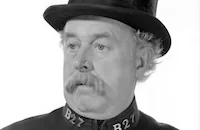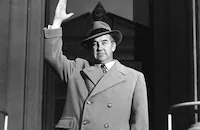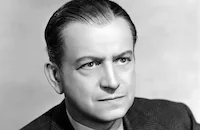The Real Glory

Brief Synopsis
Cast & Crew
Henry Hathaway
Gary Cooper
David Niven
Andrea Leeds
Reginald Owen
Broderick Crawford
Film Details
Technical Specs

Synopsis
In 1906, Colonel Hatch receives orders that the American troops he leads are to withdraw from Fort Mysang on the Philippine island of Mindanao. Hatch protests, saying that Alipang and his Moro bandits will overrun the other natives, but his commanding officer tells him that he will have to train the natives to defend themselves before he leaves. To accomplish this goal, Hatch receives aid from a team of specialists: Doctor Bill Canavan, Lieut. Terrence McCool, Capt. Steve Hartley, Lieut. Larsen and Capt. George Manning. Alipang watches as the men arrive at Mysang and orders one of his followers to kill Colonel Hatch so that the unprepared native troops will be goaded into attacking his forces in the jungle, and be slaughtered. The assassin is successful, and despite Canavan's attempts to save him, Hatch dies. Hartley receives a head wound during the attack, but recovers and becomes second-in-command to Manning. While native Lieut. Yabo and the Americans struggle to train the native troops, whose fear of Alipang debilitates them, Manning prepares to welcome his visiting wife. On the boat with Mrs. Manning is Hartley's daughter Linda, whom he has not seen in four years. Linda's visit surprises her father, and even more surprising is her determination to stay with him. She quickly becomes the focus of a romantic rivalry between Larsen, McCool and Canavan, but she seems to prefer the tough yet understanding doctor. On the night of the women's arrival, Manning falls prey to another of Alipang's assassins, and Hartley, who is going blind from his head wound, assumes command. With the help of Miguel, a Moro lad who is loyal to the Americans, Canavan captures one of Alipang's men and ridicules him to dispel the native troops' fear of the Moros. Conflict grows between Canavan and Hartley, who resents the doctor's dismissal of his orders as childish and fear-driven. Determined to lure the troops into the jungle, Alipang dams the river that flows through the village, and as the villagers are forced to use unclean water, a cholera epidemic breaks out. While Linda helps Canavan treat the ill, Miguel and Larsen lead a group of men to dynamite the dam. When they do not return, the Datu, a Moro chieftain secretly in league with Alipang, offers to lead Hartley and the troops to the dam. After they leave, Miguel returns alone, badly injured. He tells Canavan that the Datu killed Larsen, and the doctor rushes to warn Hartley. He catches up with the troops as they are being lead into an ambush, and sends them back to the village while he goes to the dam. Canavan succeeds in dynamiting the dam, but as the villagers are celebrating, they are attacked by the bandits. While Canavan orders the troops to build rafts with which they can reach the fort quickly, McCool is killed defending the ammunition stockpile. The doctor reaches the fort first and, along with Linda, defends against the marauders until the troops arrive. Yabo's men are victorious against the Moros, and peace is established in the region. Later, Hartley, Linda, Canavan and Miguel board a ship bound for home, and Yabo and his men proudly salute them goodbye.

Director

Henry Hathaway
Cast

Gary Cooper

David Niven

Andrea Leeds

Reginald Owen

Broderick Crawford

Kay Johnson

Russell Hicks

Vladimir Sokoloff
Benny Inocencio
Charles Waldron
Rudy Robles
Tetsu Komai

Roy Gordon

Henry Kolker
Elvira Rios
Luke Chan
Elmo Lincoln
John Villasin
Charles Stevens
Karen Sorrell

Soledad Jimenez
Lucio Villegas
Nick Shaid
Kam Tong
Martin Wilkins
Bob Naihe
Satini Puailoa
Kalu Sonkur Sr.
George Kaluna
Caiyu Ambol
Crew
Ralph Angel
James Basevi
Jeanne Beakhurst
Eddie Bernoudy
R. O. Binger
Jack Caffey
Paul Eagler
Samuel Goldwyn
Samuel Goldwyn
Stuart Heisler
Julia Heron
Daniel Mandell
Rudolph Maté
Archie Mayo
Alfred Newman
Jack Noyes
Robert R. Presnell
Robert Riskin
Col. William H. Shutan
Nick Stadler
Jo Swerling
Richard Talmadge
Paul Widlicska

Film Details
Technical Specs

Articles
The Real Glory
Sequestered on the Philippine island of Mindanao, the American soldiers help to fend off the hostile, attacking Moro tribesmen determined to take possession of the islands and their people.
The slowly building Moro assault led by the diabolical Moro leader Alipang (Tetsu Komai) begins guerrilla-style with the brutal murder of Colonel Hatch (Roy Gordon), designed to draw the Americans into the jungle. The Moro then murder the base commander Capt. George Manning in front of his wife, who is visiting from the mainland. His replacement, Capt. Steve Hartley is slowly going blind from a head wound sustained during the attack on Hatch, impairing his ability to lead his men and protect his visiting daughter Linda Hartley (Andrea Leeds) who he has not seen in four years.
The Moro further endanger the villagers when they dam a river, cutting off their water supply and creating an outbreak of cholera. The action-filled grand finale of the film is especially memorable, as camp doctor Bill Canavan saves the day by riding a raft down river to save the villagers from the Moro.
Viewers of The Real Glory (1939) will certainly notice several unique aspects of the Moro warfare style including their preference for machete hand to hand combat, their use of gory guerilla-style booby traps and their imperviousness to the American army's bullets. In fact, the Moslem Moro tribesmen were so resistant to .38-calibre bullets that the Army developed the .45-calibre automatic to better repel them.
The Philippine government was displeased with The Real Glory because they felt it portrayed the native Philippine soldiers as cowards, afraid of the fearless, death-defying Moro. The film's producer Samuel Goldwyn, after first refusing to alter the questionable scenes, ended up deleting some sequences on the advice of aide James Roosevelt, son of President Franklin D. Roosevelt. Representatives of the Moro might have had better grounds to object to their portrayal in the film as demonic, bloodthirsty savages.
Writers at the Daily Worker also objected to the portrait of the Moros, "In times like these, we question the wisdom of rattling the bones in Yankee imperialism's closet. To show the Moros as bloodthirsty savages is neither fair to them nor to history."
The basis for The Real Glory, Charles L. Clifford's novel first appeared in Redbook in 1937. Production on The Real Glory was delayed because of script difficulties and an injury sustained by Andrea Leeds. The writers signed to work on the film at various stages included Dudley Nichols, Charles Bennett, Sidney Howard, Howard Estabrook, Gene Fowler, Humphrey Cobb, Jan Fortune and Anthony Veiller. Background shots of the Philippines were combined with the California sets built at a cost of $200,000. Approximately 1200 Filipinos were used as extras in the film, coordinated by the daughter-in-law of the Philippine Ambassador to the United States. The production was estimated to have cost more money ($2 million) and taken more time (200 eight-hour working days) than the original 1906 campaign.
The technical advisor for the film, Colonel William H. Shutan, was the former military governor of the island of Mindanao where the film took place. Both a domestic and foreign version of the film were shot. Despite the assertion in Life magazine that the American version Òmay seem gory to U.S. audiences," it was the foreign version which emphasized the Òvisual and audible horror aspects of the Philippine uprising in graphic detail," including a scene where Lieutenant Larson is eaten alive by ants. The screen's first Tarzan, Elmo Lincoln, also had a small bit part in the film.
Gary Cooper and director Henry Hathaway had worked together previously on another jungle action adventure, The Lives of a Bengal Lancer (1935). Cooper's box office credential was boosted by his performance in The Real Glory and critics were especially enamored of Cooper as the brave and immensely capable doctor. Graham Greene remarked that "Sometimes his lean photogenic face seems to leave everything to the lens, but there is no question here of his not acting. Watch him inoculate the girl against cholera - the casual jab of the needle, and the dressing slapped on while he talks, as though a thousand arms had taught him where to stab and he doesn't have to think any more." The son of a wealthy rancher, Cooper had initially yearned to be a political cartoonist. But when he appeared in his first talking picture success, The Virginian (1929), his all-American good looks and distinctive, laconic speech patterns seemed tailor made for the cinema. Cooper was especially adept at playing American heroes, from valiant World War I soldier Alvin York in Sergeant York (1941) (for which he won an Oscar®) to baseball legend Lou Gehrig in The Pride of the Yankees (1942).
The Real Glory, which was reissued in 1942 as A Yank in the Philippines was, ironically enough, withdrawn from circulation during World War II because the Moros had become American allies.
Director: Henry Hathaway
Producer: Samuel Goldwyn, Robert Riskin
Screenplay: Jo Swerling and Robert Presnell, Sr. based on a novel by Charles L. Clifford
Cinematography: Rudolph Mate
Production Design: James Basevi
Music: Alfred Newman
Cast: Gary Cooper (Dr. Bill Canavan), Andrea Leeds (Linda Hartley), David Niven (Lt. McCool), Reginald Owen (Capt. Steve Hartley), Broderick Crawford (Lt. Swede Larson), Kay Johnson (Mabel Manning), Charles Waldron (Padre Rafael), Russell Hicks (Capt. George Manning), Roy Gordon (Col. Hatch), Benny Inocencio (Miguel), Tetsu Komai (Alipang).
BW-95m.
by Felicia Feaster

The Real Glory
Quotes
Trivia
Notes
Charles L. Clifford's novel first appeared in Redbook in 1937. The working title of this film was The Last Frontier. A December 3, 1936 Hollywood Reporter news item referred to the film as Revolt of Manilla [sic], and a October 30, 1937 Hollywood Reporter news item called it Back of Manilla [sic]. Producer Samuel Goldwyn first announced plans for the film on December 3, 1936, and a May 17, 1937 New York Times news item noted that it was to be shot in color for Goldwyn's 1937-1938 season. Production was delayed numerous times due to script difficulties and once due to an injury sustained by actress Andrea Leeds. Contemporary sources from December 3, 1936 to the beginning of production in April 1939 list many writers who were signed to work on the screenplay, although their contribution to the completed film has not been confirmed. They were: Dudley Nichols, Charles Bennett (who was borrowed from Universal) Sidney Howard, Howard Estabrook, Gene Fowler, Humphrey Cobb, January Fortune and Anthony Veiller. Among the actors considered for or signed for roles in the film, but who did not appear in the completed picture are: Merle Oberon, Keye Luke, Donald Crisp (who was borrowed from Warner Bros.) and Walter Brennan. Hollywood Reporter production charts include Maurice Moscovitch, Thurston Hall and William Stack in the cast, but their participation in the finished film has not been confirmed. Hollywood Reporter news items note that director Henry Hathaway was borrowed from Paramount and that actor Reginald Owen was borrowed from M-G-M.
A August 19, 1938 Hollywood Reporter news item noted that Goldwyn intended to destroy all of the old sets used by Mary Pickford, Douglas Fairbanks and D. W. Griffith on the United Artists backlot in order to build the Filipino village set. In protest, Griffith wrote to New York's Museum of Modern Art, requesting that they intercede and preserve the sets in permanent collection at the museum. The film's pressbook notes that the backlot set covered six acres. According to the pressbook and Hollywood Reporter news items, the dam blown up by the character "Doctor Bill Canavan" was built in the "Hunt-Salto Canyon, forty-five miles from Hollywood"; Hathaway was in charge of locations at Chatsworth; associate director Richard Talmadge shot chase scenes at Kernville; second unit director Stuart Heisler filmed other action sequences at Point Magu; and background shots from the Philippines, which were "dovetailed" in with the California locations, were provided by Philippine Films, Inc. According to a New York Times article, the scene of the dam being blown up had to be redone, and the "resultant cost of delay and refilming was more than $10,000." A April 26, 1939 Hollywood Reporter news item reported that Archie Mayo would direct two hundred Filipinos in a skirmish. Contemporary sources indicate that approximately 1,200 Filipinos were used as extras in the film, and a New York Times article states that they were supervised by a Señor Demendante and Mrs. Pacita Paredes. Paredes was the daughter-in-law of the Philippine Ambassador to the United States, and the article reported that Goldwyn was considering putting her in the film.
According to a study guide on the film written by Educational and Recreational Guides, Inc., Goldywn spent $200,000 to build the Philippine backlot set. The study guide noted that "This picture, which is based on an incident in the annals of the American Scouts in the Philippines, cost more money ($2,000,000) and took more time (200 eight-hour working days) than the original campaign in 1906!" The study guide also pointed out that Col. William H. Shutan, who acted as the technical advisor, was the former military governor of the island of Mindinao, the location of the film's action. A June 20, 1939 Hollywood Reporter news item reported that The Real Glory was being produced "in two distinct versions, one for the domestic market and a second for the foreign." The foreign version was to emphasize "visual and audible horror aspects of the Philippine uprising in graphic detail," including using a stuntman instead of a dummy for the scene in which the character "Lieutenant Larsen" is eaten alive by ants. The pressbook notes that Curly Eagles, "Hollywood's outstanding authority on insects," was in charge of the 20,000 ants that were used in the scene.
After the film was completed, it was viewed in a special screening by J. M. Elizalde, the Philippine Island Resident Commissioner, at the request of the Philippine president, Manuel Quezon. On behalf of Quezon, Elizalde requested the deletion of scenes that depicted "his people as inferior, morally afraid of the Moro Tribe and reflect[ed] in general against the courage of the Commonwealth." Goldwyn at first refused to make the deletions, but after consulting with aide James Roosevelt, the son of President Franklin D. Roosevelt, the producer gave in to the commissioner's request and deleted some sequences. According to a Hollywood Reporter news item, a full battery of two hundred artillerymen were scheduled to attend the film's press preview, which was held in Beverly Hills on September 11, 1939. According to a August 29, 1942 Motion Picture Herald news item, when The Real Glory was re-issued in 1942, the Motion Picture Division of the Office of War Information requested that it be withdrawn from distribution "because of scenes in the picture showing conflict between Americans and Filipinos." According to modern sources, the re-issue title was A Yank in the Philippines, and it had to be withdrawn because the Philippine Moros had become allies of the United States during World War II.














